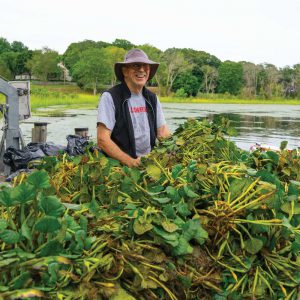The Estuary’s Most [un]Wanted Plant is Under Water
Lily Pad? Guess Again.
It’s the Invasive Water Chestnut.
By Judy Preston
Photography by Jody Dole

 The aquatic plant known as Trapa natans has the unfortunate common name of water chestnut, leading people who are first hearing about it to think that it may well be a bonus source of that good appetizer, with a strip of bacon wrapped around it.
The aquatic plant known as Trapa natans has the unfortunate common name of water chestnut, leading people who are first hearing about it to think that it may well be a bonus source of that good appetizer, with a strip of bacon wrapped around it.
But the reality is, this non-native species is an aggressive rooted aquatic plant with floating leaf rosettes and a central submerged cord that can extend up to 16 feet, enabling it to form a dense mat on the water’s surface. By July, plants produce a whorl of seeds (nuts) below the water’s surface that detach and sink once mature. Seeds have been shown to remain viable for up to twelve years, underscoring the threat of long-term establishment once this plant takes hold.

Hadlyme resident Humphrey Tyler surrounded by water chestnut plants removed by volunteers last summer from Connecticut River’s Selden Cove.
This invasive species has gradually been moving down the Connecticut River from several large concentrations in Massachusetts. In 2011, a baseline effort to locate, map, and remove occurrences in the Connecticut River estuary was funded by the US Fish and Wildlife Service, working with the Connecticut River Estuary Regional Planning Agency (subsequently RiverCOG) in Essex. Several large populations have been located in the estuary, including in Salmon Cove, Selden Cove, and even on the Connecticut River mainstem.
Early detection and control is essential to controlling Water Chestnut; extensive infestations in Lake Champlain in Vermont, and the Hudson River estuary in New York make it unlikely that complete eradication will be possible in those waters. Our estuary abounds with largely intact fresh, brackish, and saltwater tidal wetlands that are essential habitat for a concentration of resident and migratory bird and fish species. Water Chestnut has the potential to fundamentally alter the ability of the Connecticut River estuary ecosystem to continue to support the biological, economic, and social amenities that have been its hallmark.

Friends of Whalebone Cove President Diana Fiske, in blue kayak on right, helped organize more than 30 volunteers in kayaks, canoes, and motor boats...who spent more than 125 hours last summer pulling thousands of water chestnut plants out of Selden Cove.
In 2018, after the discovery of large concentrations of another aquatic invasive plant, Hydrilla, in the Connecticut River north of Middletown, an email list serve was formalized to help conservationists problem solve about how to protect the Connecticut River and its many coves and marshes. It will take the persistence, resources, and energy of many people to stem the tide of these plants in the estuary—and the entire watershed.

Hadlyme resident Joe Standart empties a bag of water chestnut plants removed by volunteers of the Hadlyme conservation group Friends of Whalebone Cove.
If you think you have found either of these plants, or are interested in helping join the effort to keep it out of the Connecticut River estuary, please contact Judy Preston ( judy.preston@uconn.edu), Margot Burns (mburns@rivercog.org), or Friends of Whalebone Cove (fowchadlyme@gmail.com).
Judy Preston works for the Long Island Sound Study and CT Sea Grant at UConn’s Avery Point campus in Groton. She lives in Old Saybrook.

One of 10 cartloads of water chestnut plants removed from Lyme’s Selden Cove last summer.